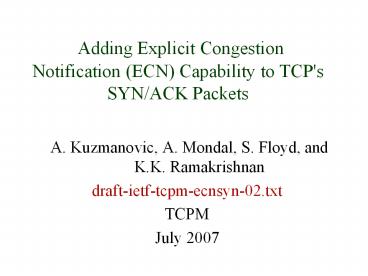Adding Explicit Congestion Notification (ECN) Capability to TCP's SYN/ACK Packets - PowerPoint PPT Presentation
Title:
Adding Explicit Congestion Notification (ECN) Capability to TCP's SYN/ACK Packets
Description:
The SYN/ACK packet can be sent as ECN-Capable only in response to an ECN-setup SYN packet. ... Set initial cwnd to one packet: Instead of setting cwnd to 2-4 packets. ... – PowerPoint PPT presentation
Number of Views:202
Avg rating:3.0/5.0
Title: Adding Explicit Congestion Notification (ECN) Capability to TCP's SYN/ACK Packets
1
Adding Explicit Congestion Notification (ECN)
Capability to TCP's SYN/ACK Packets
- A. Kuzmanovic, A. Mondal, S. Floyd, and K.K.
Ramakrishnan - draft-ietf-tcpm-ecnsyn-02.txt
- TCPM
- July 2007
2
Purpose
- Specifies a modification to RFC 3168 to allow TCP
SYN/ACK packets to be ECN-Capable. - Based on the SIGCOMM 2005 paper by A. Kuzmanovic.
- Avoids the retransmit timeout when a SYN/ACK
packet would have been dropped. - If the SYN/ACK packet is ECN-marked, the sender
of that packet responds by reducing the initial
window to one segment, instead of two to four
segments.
3
More
- The SYN/ACK packet can be sent as ECN-Capable
only in response to an ECN-setup SYN packet. - The SYN packet still MUST NOT be sent as
ECN-Capable. - The benefit of adding ECN-capability to SYN/ACK
packets can be high, particularly for small web
transfers.
4
The TODO List from March 2006
- Converge on the response to a marked SYN/ACK
packet. - Look at the costs of adding ECN-Capability in a
worst-case scenario. (From feedback from Mark
Allman and Janardhan Iyengar.) - Find out how current TCP implementations respond
when receiving a SYN/ACK packet that has been
ECN-marked?
5
Response to an ECN-Marked SYN/ACK Packet?
- Set initial cwnd to one packet
- Instead of setting cwnd to 2-4 packets.
- Continue in congestion avoidance instead of
slow-start. - OR
- Wait an RTT before sending a data packet
- Proposed by Mark Allman.
- Simulations reported in Appendix A.
6
Results from Simulations
7
Results from Simulations
8
Results from Simulations
9
Simulation Overview
- Heavy-tailed distribution of file sizes
- With a range of average file sizes.
- Topology
- Target delay 1 ms, 5 ms, 10 ms.
- 100 Mbps congested link.
- Minimum RTT of 12 ms.
- RED in gentle mode.
- Simulations with RED in packet and byte mode.
- For the simulations with RED in byte mode, SYN
packets arent dropped or marked very often. So
it doesnt make much difference if SYN/ACK
packets are ECN-Capable.
10
Lessons from Simulations
- Dangers with high congestion?
- When congestion is high, packets are dropped
rather than ECN-marked, with or without ECN. - Comparing ECN with ECN/Wait
- The overall congestion level with ECN (without
waiting) is similar to that with ECN/Wait
(waiting after an ECN/SYN packet is marked).
11
Current TCP Implementations
- Fedora Linux TCP
- Shouldnt crash after an ECN-marked SYN/ACK
packet. - Shouldnt respond to the CE codepoint in a
SYN/ACK packet either. - FreeBSD?
- Microsoft Vista?
12
Next steps?
13
Extra Viewgraphs
14
Security Concerns
- Bad middleboxes that drop ECN-Capable SYN/ACK
packets? - We dont know of any.
- If the first SYN/ACK packet is dropped, the
retransmitted SYN/ACK should not be ECN-Capable. - There is no danger on congestion collapse
- Routers are free to drop rather than mark
ECN-Capable packets. - If the SYN/ACK packet is marked, the sender sends
at most one data packet if that packet is
dropped or marked, the sender waits for a
retransmit timeout.
15
Changes in January (2006) revision
- Added a discussion to the Conclusions about
adding ECN-capability to relevant set-up packets
in other protocols. From a suggestion from
Wesley Eddy. - Added a discussion of one-way data transfers,
where the host sending the SYN/ACK packet sends
no data packets. - Added a description of SYN exchanges with SYN
cookies. From a suggestion from Wesley Eddy. - This needs further clarifications.
16
The guidelines
- RFC 3168
- Upon the receipt by an ECN-Capable transport
of a single CE packet, the congestion control
algorithms followed at the end-systems MUST be
essentially the same as the congestion control
response to a single dropped packet. For
example, for ECN-Capable TCP the source TCP is
required to halve its congestion window for any
window of data containing either a packet drop or
an ECN indication. - Question
- If TCPs response to a dropped SYN/ACK packet
a congestion control response? Or is this a
special case, allowing a new response?































